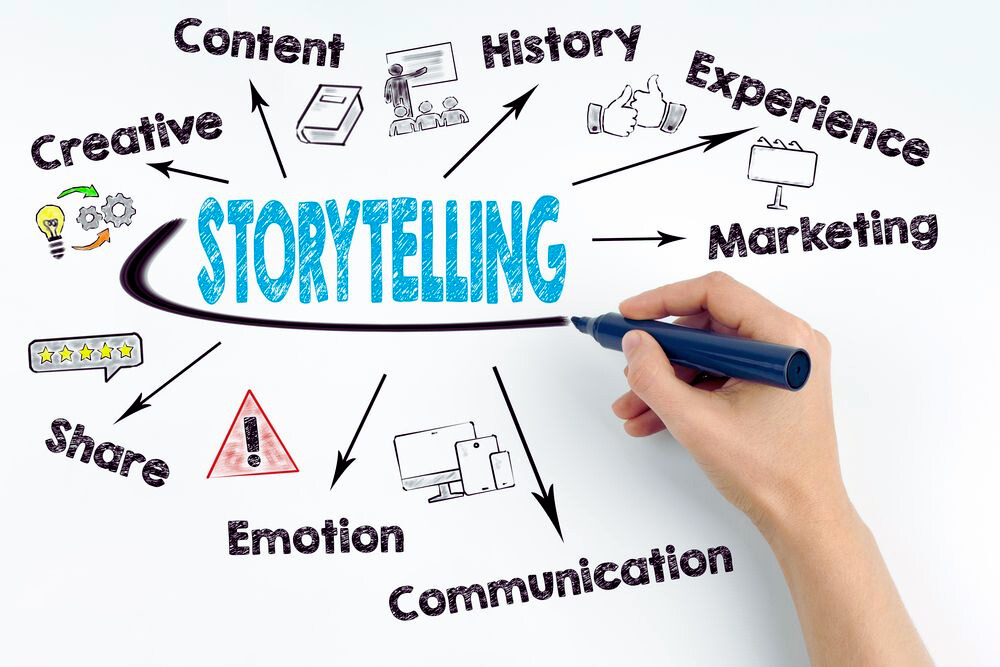In a world where information is crowded and voices compete for attention, it has become The art of storytelling One of the most important skills that distinguishes leaders, professionals, and entrepreneurs, the ability to transform an idea into a compelling story is no longer a luxury; it has become a strategic tool for influencing, persuading, and building strong relationships with audiences.
Since the dawn of history, stories have been humanity’s primary means of understanding the world around them. Our ancestors used them to convey values, experiences, and lessons. Today, storytelling retains its enchanting power, but with modern methods that serve marketing, leadership, education, and management. Therefore, it can be said that a story is not just a tale; it is an integrated means of communication that builds bridges of trust and inspiration between you and your audience.
🎯 First: Why is the art of storytelling an indispensable tool in communication?
When you tell a good story, you don’t just provide information, you evoke emotions and create an experience that the audience lives with you moment by moment. That’s why it depends on The art of storytelling is based on psychological and human principles that make the message more impactful and lasting in the mind.
1. The story moves emotions and builds human connection.
The mind may argue, but the heart believes. When you tell a story, you open a window to empathy and interaction, making your audience feel part of the event.
For example, If you share a story about how your first business failed and how you learned from it, listeners will feel close to you because they’ve been through similar experiences.
2. Simplify complex information
Data and numbers are often static, but when you put them into a story, they gain meaning.
Instead of saying, “We’ve grown by 20%,” you can tell how the team overcame challenges to achieve this growth. This way, the number becomes an achievement that the audience can visualize and appreciate.
3. Attract attention and break the boredom
It’s natural for an audience to lose focus after a few minutes of a show filled with numbers and text, but narration brings the feeling back to life.
Additionally, when you start your presentation with a mysterious question or an interesting situation, you ensure that the audience is engaged from the very first moment.
4. Enhancing persuasion and influence
Every good story plants an idea. When audiences hear a true story of success or transformation, they tend to believe the message and follow suit.
Thus, it can be said that the story persuades without imposing, and influences without arguing.
💡 Second: How do you build an inspiring and powerful story in your presentations?
To master the art of storytelling, you must follow a clear approach to constructing your story so that it is logical, engaging, and applicable. Here are the basic steps:
1. Start with The Hero’s Journey model.
This model is one of the most widely used techniques in effective storytelling. It consists of three interconnected stages:
- Current Reality: Introduce the audience to the problem or situation.
- Challenge and transformation: Highlight the obstacles the hero (client, company, or even you) faced.
- Inspirational Ending: Conclude the story with a twist and a positive outcome.
For example, If you’re presenting on digital transformation, you could start with a company that was underperforming, then tell the story of how it adopted digital solutions and completely transformed its results.
2. Link facts to emotions.
People don’t remember numbers as much as they remember feelings. So, connect the data to a feeling or experience.
Instead of saying, “70% of businesses fail in their first year,” say, “Imagine you put in a whole year of effort, then find yourself forced to close your business… That’s what 70% of entrepreneurs face.”
3. Use simple and smooth language.
Narrative is not literary rhetoric. The audience wants to understand and react quickly.
So, use familiar words and short sentences that connect the idea to the action. The more natural the language, the more relatable and easy to understand the story.
4. Make the audience the hero
The most important rule in the art of storytelling The story is not about you, it’s about your audience.
Use the second-person pronoun, such as: “Have you ever faced a similar situation?” or “How would you feel if you were in his place?”
In this way, the listener feels like he is part of the story, not just a spectator.
5. Use similes and mental images.
Similes help the audience see what you are saying.
For example: “Innovation is like planting a tree. It won’t grow overnight, but it will bear fruit if you continue to nurture it.”
With this type of photography, an abstract idea is transformed into a vivid and unforgettable image.

🧩 Third: How do you apply storytelling in presentations and meetings?
You may have great ideas, but presenting them the wrong way can make them lose their impact. Therefore, it’s important to know how to use narrative intelligently in presentations.
1. Turn the presentation into a complete story.
Instead of making rigid points, make each slide represent a chapter of the story:
- Introduction: Why are we here?
- Problem: What challenge do we face?
- Solution: How to overcome it?
- Conclusion: What is the expected outcome?
This sequence keeps the audience’s attention and makes your presentation logical and flowing.
2. Start with suspense
You can start the presentation with a question, a riddle, or a real situation.
For example: “In 2007, a major company nearly went bankrupt, but today it’s one of the most successful companies in the world. Do you know what changed its fate?”
This way, you arouse curiosity and keep the audience waiting for the answer.
3. Use voice and body language intelligently.
The story is not told with words alone, but with feelings.
Vary your tone of voice according to the situation, use pauses at important moments, and express enthusiasm or challenge with your body.
Eye contact and body language increase your credibility and make your message more impactful.
4. Support the narrative with images.
Pictures evoke emotions faster than text.
Choose images that express a mood: success, challenge, or inspiration.
Also, make sure that the colors are harmonious and easy on the eye, because a good image completes the story and does not distract attention.
Fourth: The most important techniques and strategies for effective storytelling
To master storytelling and use it intelligently, here are a set of proven techniques:
1. “Before and after” technique
Start by describing the situation before the change, then move on to what happened after the solution.
For example, Talk about a team that was underperforming, and then explain how the situation changed after implementing a new strategy.
2. Three-point rule
A good story doesn’t need twenty ideas, but three clear main messages.
The human mind remembers information when it is brief and focused.
3. Use dialogue
Dialogue makes the story more realistic and lively.
Instead of saying, “Ahmed faced rejection from his manager,” say:
“I believe this idea will work,” Ahmed said confidently. “Convince me first,” the manager replied with a smile.
Here the reader feels that he is experiencing the event himself.
4. Conclude with an inspiring message.
Every story needs a purpose. So, end with a question or call to thought, such as:
“What story could change the way you present your next idea?”
🌟 Fifth: Storytelling in Work and Leadership
Successful leaders don’t just rely on orders, they use stories to build inspiration and confidence.
Instead of saying, “We need to increase production,” a manager can share a story about a team that overcame challenges and achieved success.
In this way, the message turns from a command into an intrinsic motivation.
Coaches and marketers can also use stories to build trust and persuade clients without direct pressure.
🚀 Sixth: How do Reins help you master the art of storytelling?
At
Reins
, we believe that a powerful story can transform communication from mere words to an impactful experience.
So, we designed A specialized workshop on “Mastering the Art of Storytelling for Presentations” aims to:
- Develop your skills in building impactful stories.
- Improve your ability to influence and persuade an audience.
- Transform your presentations into inspiring, memorable experiences.
📩
Start today!
Join the Reins Workshop Be the storyteller who grabs attention, inspires the audience, and leads with thought and story.










